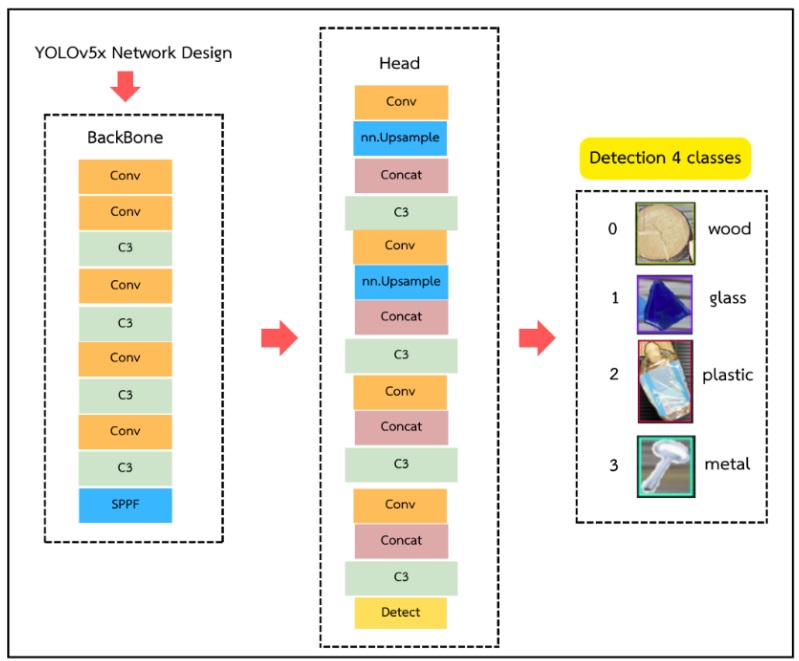Efficient Waste Detection and Classification based on YOLOv5 Models
doi: 10.14456/mijet.2024.7
Keywords:
YOLOv5, Waste Detection, Artificial Intelligence, Image Processing, Efficient Waste DetectionAbstract
This paper proposes efficient waste detection and classification based on YOLOv5 by utilizing YOLOv5 for waste detection and classification. Divide the dataset into 4 classes consisting of wood, glass, plastic, and metal. The dataset is methodically divided into three subsets: the training set consisting of 1,860 images, the validation set consisting of 200 images, and the test set consisting of 235 images. The objective of our study is to assess the effectiveness of three YOLOv5 models, namely Yolov5s, Yolov5m, and Yolov5x, across several waste object categories. The methodology employed in this research is as follows: Compilation of datasets and development of models specific to each iteration of YOLOv5. Comparing models. We assess the precision, recall, and mean average precision (mAP) to measure the correctness and speed of their processing. The empirical findings from our investigation suggest that Yolov5x demonstrates the highest level of accuracy and mAP scores (0.41), whilst Yolov5s showcases the shortest processing time (0.83 hours).
References
D. Bandukwala, M. Momin, A. Khan and L. Islam, “Object Detection using YOLO,” International Journal for Research in Applied Science and Engineering Technology, vol. 10, no. 5, pp. 823–29, DOI: 10.22214/ijraset.2022.42088, 2022.
S. Chaudhari, N. Malkan, A. Momin and M. Bonde, “Yolo Real Time Object Detection,” International Journal for Research in Applied Science and Engineering Technology, vol. 10, no. 5, pp. 823–29, DOI: 10.14445/22312803/IJCTT-V68I6P112, 2020.
A. George, “Object Detection Using YOLO Algorithm,” Kristu Jayanti Journal of Computational Sciences (KJCS), Kristu Jayanti College (Autonomous), pp. 25–37, DOI: 10.59176/kjcs.v2i1.2219, 2022.
S. Kale, D. Gore and S. Suchitra, “Traffic Sign Detection using Yolo v5,” International Journal for Research in Applied Science and Engineering Technology, vol. 11, no. 5, pp. 2679–83, DOI: 10.22214/ijraset.2023.51591, 2023.
P. Kim, Z. Fang and X. Huang, “SSD PCB Component Detection Using YOLOv5 Model,” Journal of Information and Communication Convergence Engineering, vol. 21, no. 1, pp. 24–31, DOI: 10.56977/jicce.2023.21.1.24, 2023.
T. Kiyokawa, H. Katayama, Y. Tatsuta, J. Takamatsu and T. Ogasawara, “Robotic Waste Sorter with Agile Manipulation and Quickly Trainable Detector,” IEEE Access, vol. 9, 2021, pp. 124616–31, DOI: 10.1109/ACCESS.2021.3110795, 2021.
H. Kusumah, M. S. Zahran, K. N. Rifqi, D. A. Putri and E. M. Hapsari, W, “Deep Learning Pada Detektor Jerawat: Model YOLOv5,” Journal Sensi, vol. 9, no. 1, pp. 24–35, DOI: 10.33050/sensi.v9i1.2620 2023.
H. Liu and Q. Wu, “An Improved YOLO for Road and Vehicle Target Detection Model,” Journal of ICT Standardization, DOI: 10.13052/jicts2245-800x.1125, 2023.
L. Shao, H. Wu, C. Li and J. Li, “A Vehicle Recognition Model Based on Improved YOLOv5,” Electronics, vol. 12, no. 6, p. 1323, DOI: 10.3390/electronics12061323, 2023.
A. Tahir, S. K. Khalid and L. Fadzil, “Child Detection Model Using YOLOv5,” Journal of Soft Computing and Data Mining, vol. 4, no. 1, DOI: 10.30880/jscdm.2023.04.01.007 2023.
Z. Wang, L. Wu, T. Li and P. Shi, “A Smoke Detection Model Based on Improved YOLOv5,” Mathematics, vol. 10, no. 7, p. 1190. DOI: 10.3390/math10071190, 2022.
L. K. Wani, M. M. Momin, S. Bhosale, A. Yadav and M. Nili, “Vehicle Crash Detection using YOLO Algorithm,” International Journal of Computer Science and Mobile Computing, vol. 11, no. 5, pp. 75–82, DOI: 10.47760/ijcsmc.2022.v11i05.007, 2022.
R. M, R. Y A, R. B. S, P. K. R and S. N, “Waste and Vehicle Detection Using YOLO,” International Journal for Research in Applied Science and Engineering Technology, vol. 10, no. 5, pp. 3587–90, DOI: 10.22214/ijraset.2022.43124, 2022.
G. Jocher, A. Stoken, J. Borovec, NanoCode012, L. Changyu, A. Hogan and A Rituerto, Ultralytics/yolov5: v3.0, GitHub, [Online], Available: https://github.com/ultralytics/yolov5, 2020.
A. Bochkovskiy, C. Y. Wang and H. Y. M. Liao, “YOLOv4: Optimal speed and accuracy of object detection,” arXiv preprint arXiv:2004.10934, 2020.
J. Redmon and A. Farhadi, “YOLOv3: An incremental improvement,” arXiv preprint arXiv:1804.02767, 2018.
C. Y. Wang, A. Bochkovskiy and H. Y. M. Liao, “Scaled-YOLOv4: Scaling Cross Stage Partial Network,” arXiv preprint arXiv:2011.08036, 2021.
I. Kumpala, N. Wichapha and P. Prasomsab, “Sugar Cane Red Stripe Disease Detection using YOLO CNN of Deep Learning Technique,” Engineering Access, 8(2), 192–197, 2022, doi: 10.14456/mijet.2022.25.
Y. Chen, “YOLO-MS: Rethinking Multi-Scale Representation Learning for Real-time Object Detection,” arXiv:2308.05480, 2023.
J. Khoramdel, “YOLO-Former: YOLO Shakes Hand With ViT,” arXiv:2401.06244, 2024.

Downloads
Published
How to Cite
Issue
Section
License

This work is licensed under a Creative Commons Attribution-NonCommercial-NoDerivatives 4.0 International License.








